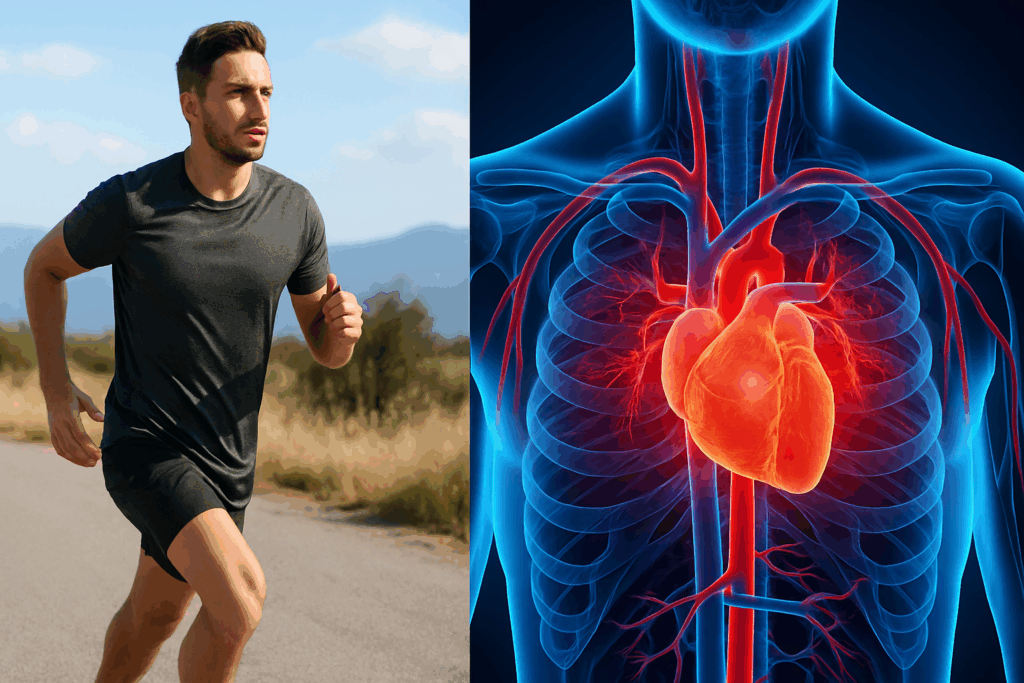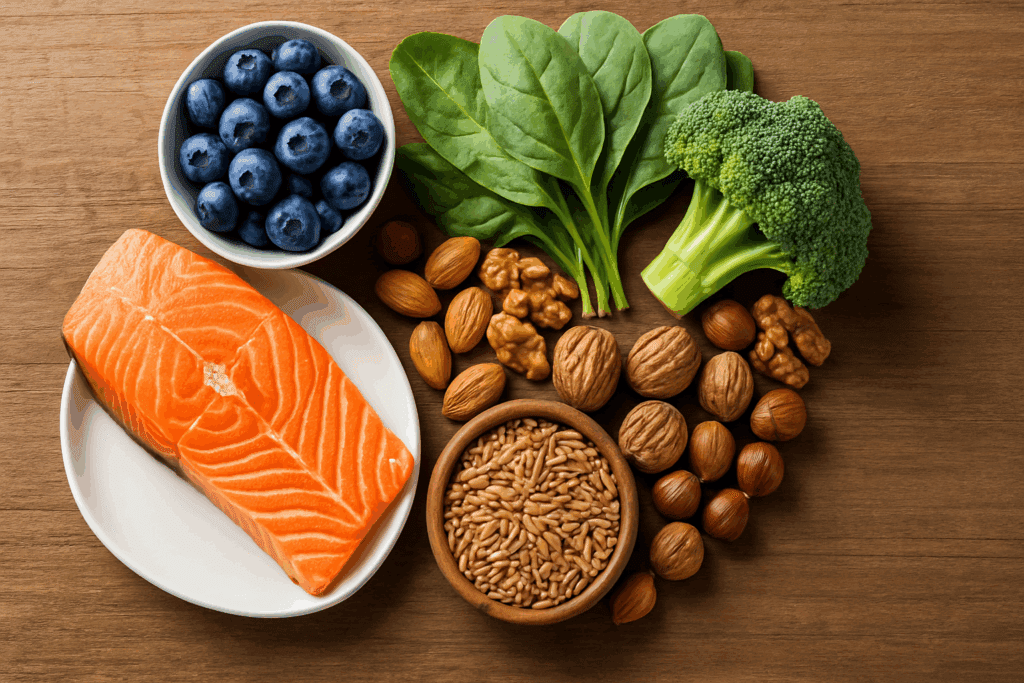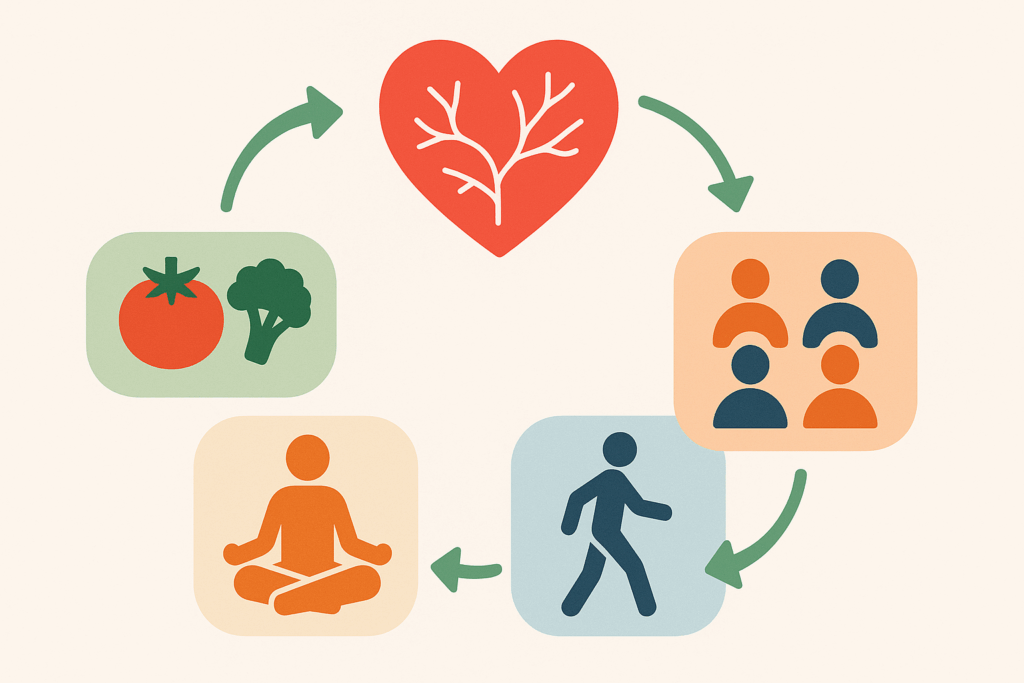In the realm of endurance and stamina training, heart health stands as the cornerstone of both performance and longevity. A strong cardiovascular system does more than support your fitness goals—it acts as a buffer against life-threatening conditions such as heart attack, stroke, and congestive heart failure. Whether you’re an athlete or someone simply seeking better health, understanding how to prevent heart attack while naturally boosting cardiovascular endurance is essential. This dual focus not only enhances your daily energy but also fortifies your long-term wellness.
The modern lifestyle, filled with stress, sedentary routines, and poor dietary habits, contributes to an alarming rise in cardiovascular conditions. Fortunately, integrating natural heart health strategies with performance-focused training can reduce risk, reverse damage, and improve overall vitality. This article provides a science-backed, practical guide for how to prevent heart disease and optimize stamina, weaving in key lifestyle changes that work synergistically with your body’s natural capacity for resilience and repair.
You may also like: Smart Nutrition Choices for a Healthier Lifestyle: What to Know About Whole Grain Rice and Whole Wheat Rice

Why Cardiovascular Health Is Essential for Endurance and Performance
The heart is far more than a pump—it’s the powerhouse of physical performance. Whether you’re running a marathon or managing daily stress, your heart’s ability to circulate oxygen-rich blood efficiently is what keeps you moving, thinking, and thriving. A strong heart delivers nutrients and oxygen to working muscles, regulates temperature, and helps remove metabolic waste. When this system is compromised, performance suffers—often long before more obvious symptoms of heart disease appear.
Boosting endurance requires a cardiovascular system that can handle the demands of both exertion and recovery. Therefore, strategies for how to prevent cardiovascular disease directly enhance athletic performance. Aerobic conditioning improves cardiac output, while interval training challenges the heart to adapt to varying intensities. The link between endurance and heart safety is undeniable: when the heart functions optimally, so does the body. Cardiovascular health promotion is not a luxury—it’s a foundational necessity for sustained physical achievement.
The Truth Behind the “7 Second Trick to Prevent Heart Attack”
You may have come across online claims about a so-called “7 second trick to prevent heart attack.” While the idea of a quick fix is appealing, it’s important to look at the science behind such claims. Some interpretations of this concept refer to simple but effective stress-reduction techniques, such as controlled deep breathing or coughing to stimulate vagus nerve activity. These actions may momentarily influence heart rate or rhythm and are sometimes used in emergency medicine to manage sudden arrhythmias.
However, these techniques are not a substitute for long-term, evidence-based practices. Relying solely on a trick like this to protect your heart is risky and shortsighted. Preventive care for heart disease requires consistent lifestyle habits, not viral hacks. While mindfulness and breathing exercises can complement a heart-healthy lifestyle, they must be part of a broader strategy. In the context of how to stop heart disease, sustainable behavior change, not shortcuts, remains the gold standard.

Building a Daily Routine That Protects Your Heart
Preventing cardiovascular disease begins with what you do every day—not once in a while. The most effective strategies for how to avoid heart attack are deeply rooted in habit. Regular physical activity is essential, with aerobic exercises like walking, cycling, and swimming shown to reduce blood pressure, improve cholesterol levels, and increase cardiac efficiency. Strength training, when incorporated properly, also supports heart health by improving glucose metabolism and lowering fat mass.
Diet is equally important. A natural heart-supportive diet includes plenty of leafy greens, berries, whole grains, legumes, fatty fish, and nuts. Reducing processed foods, added sugars, and trans fats can significantly decrease cardiovascular disease risk. In fact, many of the most powerful ways to prevent heart disease are found in your grocery cart. Moreover, sufficient sleep, hydration, and stress management complete the foundation for how to prevent cardiovascular naturally and sustainably.

Raining Smarter: Exercise Strategies That Improve Heart Safety and Endurance
For athletes and fitness enthusiasts, endurance training must be carefully balanced with heart safety. High-intensity interval training (HIIT) is a popular method that challenges the cardiovascular system in bursts, alternating periods of exertion with rest. Studies show HIIT improves VO2 max and heart efficiency, making it a valuable tool in any endurance plan. However, overtraining or neglecting rest can have the opposite effect—straining the heart and increasing inflammation.
A personalized exercise routine that includes aerobic endurance, moderate strength training, and active recovery is ideal. It’s essential to listen to your body, track performance metrics like heart rate variability, and gradually increase training intensity. These practices not only help prevent injury but also support the heart in adapting to higher workloads. This is how you build stamina while also focusing on how to prevent cvd with precision and care.

Managing Stress for Long-Term Cardiovascular Health
Emotional stress is one of the most overlooked contributors to heart disease. Chronic stress can elevate cortisol and adrenaline levels, increasing blood pressure and encouraging arterial plaque buildup. For this reason, part of how to avoid heart disease includes learning how to manage psychological and emotional triggers.
Meditation, yoga, and nature exposure are powerful tools in cardiovascular health promotion. Even practices as simple as gratitude journaling or deep breathing for a few minutes a day can have measurable benefits. When used consistently, these methods help decrease cardiovascular disease risk while promoting inner calm. Stress is inevitable, but your response to it is what determines long-term outcomes.

Smart Nutrition as Preventive Care for Heart Disease
Nutritional choices are among the most influential factors in heart health. Knowing how to prevent coronary artery disease through diet involves more than just cutting fat. The focus should be on increasing nutrient-dense, anti-inflammatory foods that nourish the heart and reduce oxidative stress. Omega-3 fatty acids, fiber, plant-based proteins, and antioxidants form the core of a cardioprotective diet.
Equally important is how you eat. Large, infrequent meals can spike insulin and blood sugar levels, putting stress on the cardiovascular system. Eating smaller, balanced meals throughout the day stabilizes glucose and supports metabolic efficiency. These practices are key in how to reverse heart disease fast when paired with exercise and lifestyle modifications.
Supplements may offer additional support when used wisely. CoQ10, magnesium, potassium, and plant sterols have been studied for their roles in decreasing inflammation, lowering LDL cholesterol, and enhancing cardiac output. However, supplements should complement—not replace—a solid dietary foundation.

Can You Reverse Heart Disease? What the Science Says
For many, the idea of reversing heart disease sounds too good to be true. However, research has consistently shown that it is possible to reverse heart problems—particularly in early or moderate stages—through comprehensive lifestyle change. One of the most notable programs, led by Dr. Dean Ornish, demonstrated regression of coronary artery blockage using a low-fat plant-based diet, stress management, moderate exercise, and social support.
This doesn’t mean you can skip medical treatment, but it does suggest a powerful role for behavior. When seeking how to reverse heart disease, consistency is everything. Smoking cessation, alcohol moderation, and proper sleep hygiene all play supporting roles. Progress may be gradual, but for many, symptoms like angina can lessen, and measurable improvements in heart function can occur. These outcomes support the idea that coronary disease prevention is not only possible but practical with the right plan.
Preventing Congestive Heart Failure Through Lifestyle Medicine
Congestive heart failure (CHF) is a condition where the heart can’t pump blood effectively, often following years of untreated cardiovascular strain. Preventing CHF is a multifactorial process that includes controlling blood pressure, managing diabetes, and avoiding heart muscle damage. Early signs like fatigue, leg swelling, and shortness of breath should never be ignored.
Understanding how to prevent congestive heart failure requires integrated care. Lifestyle medicine plays a vital role, but regular checkups, diagnostic imaging, and adherence to prescribed medications are also crucial. Weight management, reduced sodium intake, and increased physical activity help delay or prevent progression. Preventive strategies here must be proactive—not reactive—to reduce the risk of life-altering complications.

The Role of Social Connection and Accountability in Heart Safety
Heart health isn’t just about what you do alone—it’s also about who surrounds you. Strong social networks have been linked to better health outcomes, including reduced cardiovascular disease risk. Emotional support improves stress response, promotes adherence to treatment plans, and fosters positive behaviors like regular exercise and healthy eating.
Support groups, walking clubs, or even digital health communities can provide encouragement and accountability. They help answer not only how we can avoid heart disease, but how we can build resilience together. Relationships that uplift you emotionally also protect you physically. This makes social connection a vital component of any strategy for how to prevent cardiovascular disease and live longer, stronger, and more meaningfully.
Frequently Asked Questions: Natural Strategies to Prevent Heart Disease and Enhance Cardiovascular Health
1. What are some lesser-known ways to prevent a heart attack beyond diet and exercise? In addition to the well-established benefits of diet and exercise, there are emerging strategies in cardiac health promotion that focus on micro-recovery techniques and environmental influences. One example is incorporating brief mindfulness sessions throughout the day, which help stabilize heart rate variability and reduce blood pressure over time. Another includes exposure to natural green spaces or “forest bathing,” which has been shown to reduce cortisol and inflammatory markers, contributing to how to prevent heart disease in less conventional ways. Optimizing indoor air quality and minimizing exposure to traffic pollution are also gaining attention in discussions on how to avoid heart attack and stroke. These nuanced approaches illustrate that preventive care for heart disease requires attention not only to lifestyle but also to environment and emotional well-being.
2. Is there any scientific support for the ‘7 second trick to prevent heart attack’? The phrase “7 second trick to prevent heart attack” has gained popularity online, often described as a simple breathing or coughing technique used in emergency situations. While not a replacement for medical intervention, controlled coughing and deep breathing may temporarily improve circulation or regulate heart rhythm by stimulating the vagus nerve. In specific cases of arrhythmia, this technique has been used to manage symptoms until professional help arrives. However, it is not a reliable method for long-term heart safety or coronary disease prevention. Instead, it should be viewed as an emergency coping measure, while comprehensive strategies on how to prevent heart attack and decrease cardiovascular disease risk remain centered on consistent lifestyle improvements.
3. How can emotional health influence cardiovascular disease risk? Emotional health is intricately connected to cardiovascular outcomes. Chronic anxiety, unresolved trauma, and social isolation are all associated with increased inflammatory markers and higher incidence of heart events. In fact, understanding how to prevent cardiovascular disease must now include addressing mental health with the same priority as diet or fitness. Techniques such as cognitive behavioral therapy (CBT), emotional regulation training, and community engagement have shown promising results in lowering blood pressure and reducing risk factors for heart disease. These approaches offer novel ways to prevent heart disease by strengthening psychological resilience and social support systems, both of which significantly affect the heart.
4. Are there cultural or regional diets that offer insights into how to reverse heart disease? Yes, many cultural diets offer valuable lessons on how to reverse heart disease naturally. The Okinawan diet, which is low in saturated fats and high in vegetables, seaweed, and soy products, is associated with one of the world’s lowest rates of ischaemic heart disease. Similarly, the Nordic diet emphasizes root vegetables, berries, fatty fish, and whole grains, providing heart-protective nutrients that support how to reverse heart problems in a sustainable way. These dietary models show that natural heart healing can be guided by traditional patterns that evolved without reliance on processed foods. When paired with physical activity and stress-reduction practices, such cultural diets represent some of the most effective methods for cardiovascular health promotion.
5. What role does technology play in modern heart safety and prevention strategies? Technology is revolutionizing the way we approach how to prevent cardiovascular and related chronic conditions. Wearable devices now allow real-time tracking of heart rate variability, blood oxygen levels, and sleep patterns, offering users insights into their cardiovascular load. Apps focused on guided breathing, meditation, and personalized nutrition also support heart safety goals through consistent digital reinforcement. Furthermore, telehealth has made preventive care for heart disease more accessible, especially for individuals in underserved areas. These innovations help people implement ways to prevent heart disease that are tailored, scalable, and deeply integrated into daily life.
6. Can you describe the role of fasting in cardiovascular health promotion? Intermittent fasting and time-restricted eating have emerged as promising tools for how to prevent cvd and improve overall metabolic health. Fasting has been shown to improve insulin sensitivity, reduce oxidative stress, and lower resting heart rate—all factors that decrease cardiovascular disease risk. In some individuals, these approaches may also reduce LDL cholesterol and triglyceride levels. However, fasting should be personalized and done under medical supervision, especially for those with diabetes or existing cardiovascular concerns. While it is not a universal solution, fasting represents a non-pharmaceutical option for healthy heart lifestyle changes that support both longevity and performance.
7. How can we improve community-level efforts for the prevention of CHD and heart failure? To expand prevention of CHD (coronary heart disease) and congestive heart failure, public health strategies must shift toward accessibility and education. Community fitness initiatives, subsidized produce programs, and early screening events are powerful tools for primary prevention for heart disease. Involving local leaders and trusted cultural figures helps increase engagement and compliance, especially in high-risk populations. Schools and workplaces can also play a role by integrating heart education and active lifestyle opportunities into daily routines. When asking how can we avoid heart disease collectively, the answer often lies in removing barriers and building supportive infrastructures that promote cardiovascular wellness from the ground up.
8. What genetic insights are helping us understand how to prevent coronary artery disease more effectively? Advancements in genetic testing now allow for the identification of inherited risk factors for coronary artery disease long before symptoms emerge. For instance, individuals with familial hypercholesterolemia can begin treatment early to reduce their risk of heart attack or stroke. Polygenic risk scoring is another tool being developed to predict how to prevent coronary artery disease through personalized prevention plans. These include tailored nutrition, targeted exercise, and specific pharmaceutical interventions for high-risk gene carriers. This integration of genomics into heart safety strategies marks a new era in preventive care for heart disease, where interventions are not only timely but also highly individualized.
9. Are there gender-specific considerations in how to prevent heart attack and cardiovascular disease? Yes, understanding how to prevent heart attack and how to stop heart disease requires recognizing gender differences in symptoms, risks, and treatment responses. Women, for example, are more likely to experience atypical symptoms such as fatigue, nausea, and anxiety during cardiac events, which can delay diagnosis and care. Hormonal fluctuations, pregnancy-related hypertension, and autoimmune conditions also contribute to higher cardiovascular risk in women. For men, stress and poor sleep habits tend to play a more significant role in how to prevent cardiovascular decline. Gender-informed strategies, including education and screening tailored to each group, are essential in improving heart safety and reducing the global burden of cardiovascular disease.
10. What future innovations might redefine how we approach natural heart health and endurance training? Emerging research into cardiac regeneration, AI-based diagnostic tools, and biomechanical wearables is poised to transform how we implement cardiovascular health promotion. Scientists are studying stem cell therapies and tissue engineering to regenerate damaged heart muscle, which could change how to reverse heart disease fast in clinical settings. Additionally, predictive algorithms may soon help identify subtle changes in heart function well before symptoms arise, giving new tools for early intervention. For athletes and endurance enthusiasts, smart fabrics embedded with biometric sensors could fine-tune training to avoid overexertion and support natural heart recovery. These innovations signal a future where natural heart care and performance enhancement are more precise, personalized, and preventive than ever before.
Conclusion: Long-Term Heart Safety Is the Ultimate Endurance Strategy
Understanding how to prevent heart attack and improve cardiovascular performance is about more than crisis prevention—it’s a daily investment in your strength, stamina, and future. True endurance comes not just from training harder but from living smarter. Through healthy heart lifestyle changes—physical activity, nutritious eating, stress reduction, and meaningful social ties—you build the foundation for a life of both vitality and protection.
The heart does not simply respond to effort—it responds to consistency, balance, and care. Whether you’re interested in the science of how to prevent cardiovascular disease or seeking natural heart solutions for performance, the principles remain the same: small, intentional actions create massive long-term benefits. By embracing these strategies today, you’re not only reducing the risk of coronary events but also unlocking your body’s true potential.
Let heart safety be your compass, endurance your journey, and every beat a step toward a more resilient you.
Was this article helpful? Don’t let it stop with you. Share it right now with someone who needs to see it—whether it’s a friend, a colleague, or your whole network. And if staying ahead on this topic matters to you, subscribe to this publication for the most up-to-date information. You’ll get the latest insights delivered straight to you—no searching, no missing out.
Further Reading:
30 ways to Improve Your Heart Health Naturally
How Does Exercise Help Damaged Heart Muscles?
Disclaimer
The information contained in this article is provided for general informational purposes only and is not intended to serve as medical, legal, or professional advice. While NewsHealthWatch strives to present accurate, up-to-date, and reliable content, no warranty or guarantee, expressed or implied, is made regarding the completeness, accuracy, or adequacy of the information provided. Readers are strongly advised to seek the guidance of a qualified healthcare provider or other relevant professionals before acting on any information contained in this article. NewsHealthWatch, its authors, editors, and contributors expressly disclaim any liability for any damages, losses, or consequences arising directly or indirectly from the use, interpretation, or reliance on any information presented herein. The views and opinions expressed in this article are those of the author(s) and do not necessarily reflect the official policies or positions of NewsHealthWatch.

